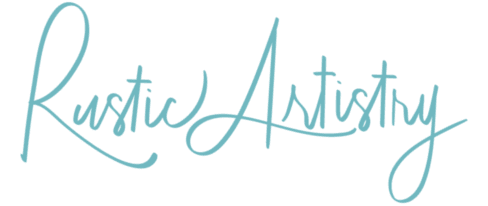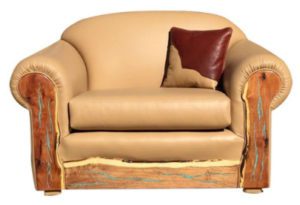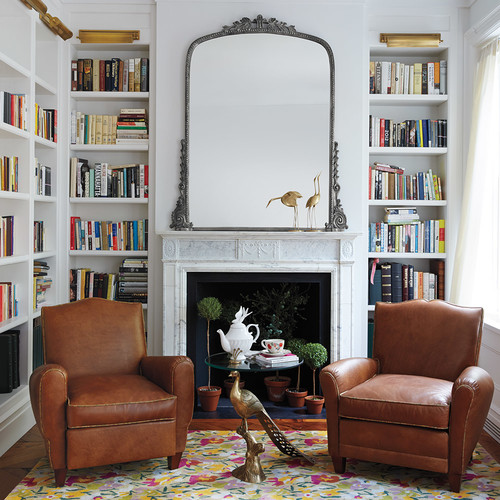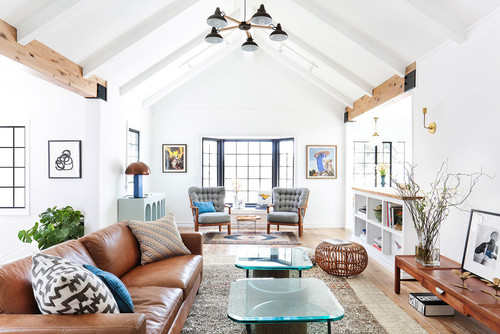How to Clean Leather Furniture
Learn the best methods for keeping various kinds of leather upholstery in top condition
Keep your leather furniture looking like new with these tips from Houzz contributor Julie Sheer.
Leather is one of the more durable, low-maintenance surfaces for home furnishings. Keeping your leather sofa, chair or ottoman clean is relatively simple if you follow the proper steps. But different types of leather upholstery have different cleaning requirements, so you first need to know what type of leather you have. Here’s how to identity, clean and maintain your leather upholstery to keep it looking great.
Types of Leather Upholstery
To find out what kind of leather upholstery you have, and the recommended care, start by checking the label or the written materials that came with the piece, or look up the item on the retailer’s or manufacturer’s website. If you don’t have access to care instructions and you’re not sure what kind of leather you have, here are some clues.
Unprotected leather. Aniline leather — also called pure aniline, full aniline or unfinished leather — has a soft, luxurious feel. The leather is dyed through with aniline dye but has no surface pigment color added. It has little or no protective coating other than perhaps a dirt-resistant treatment. Natural surface grains and markings may be seen on the leather, which can develop a patina.
Aniline leather is more sensitive to staining than protected leather and typically is pricier as well. Other types of aniline leather include pull-up leather, which is injected with oils and waxes, and nubuck leather, which has been distressed or buffed to create a soft, velvety feel.
Protected leather. Most leather furniture is made with protected, or finished, leather. These leathers may be labeled semi aniline, aniline plus pigment or pigmented leather. Protected leather is more durable, stain-resistant and uniform in appearance than pure aniline.
Semi aniline leather is aniline-dyed and topped with a layer of pigment color. It has a soft feel like pure aniline leather but is a little more durable due to the protective pigment coating. Other protected leathers are coated with thicker layers of pigment and polymer. They have a stiffer feel and stand up to more wear and tear.
Caring for Your Leather Upholstery
Skip the home potions. When it comes to cleaning leather upholstery, keep it simple and avoid DIY remedies. Homemade solutions using mayonnaise and vinegar are best kept to salads and sandwiches, and not the leather-cleaning menu. Donna L. Frehafer, from Wellington’s Leather Furniture in Port Ludlow, Washington, has seen clients harming their furniture with everything from hair-care products to Pine-Sol. Keep in mind that warranties can be voided if the wrong cleaner or conditioner is used on leather furniture. The most important thing is to avoid applying anything that is not endorsed by the tanneries, Frehafer says.
Cleaning Materials
- Vacuum cleaner with brush attachment
- Distilled water
- Mild, neutral-pH nondetergent liquid soap, such as Neutrogena or Dove, or a leather cleaner designed for furniture upholstery
- Soft white microfiber cloths
- Tarp or drop cloth
- Commercial leather conditioner (optional)
Cleaning unprotected leather. Some furniture makers recommend doing nothing more than dusting unprotected aniline leather with a clean, dry cloth and vacuuming it regularly using a soft brush attachment. Others advise gently wiping the surface with a cloth slightly dampened with distilled water, or cleaning it with an approved leather cleaner. The natural look is sensitive to scratching and staining, so take care when cleaning. Consult the manufacturer’s cleaning directions or a leather cleaning professional before using any products, and test them out first on a hidden surface.
Cleaning protected leather. Semi aniline and especially pigmented leather can stand up to heavier use and cleaning than aniline leather. But stay away from products containing ammonia or alkalies, which can damage leather beyond repair, according to the Institute of Inspection, Cleaning and Restoration Certification. Avoid saddle soap, detergents, oils, furniture polishes, abrasive materials and any cleaners with caustic ingredients.
Commercial leather cleaning brands recommended by some furniture makers include Leather Honey, Lexol and Chemical Guys.
Cleaning Steps
- Here are the steps for cleaning protected leathers. Always try them first on an inconspicuous spot that can’t be seen. And put down a drop cloth to catch any water drips.
- Remove dirt by vacuuming the furniture piece using the brush attachment.
- Add a few drops of mild non-detergent soap to distilled water to create a cleaning solution. Moisten a microfiber cloth with the solution.
- Test an inconspicuous spot with the cloth to make sure there’s no discoloration from the soap and water.
- Working from top to bottom, wipe the furniture.
- Dampen another cloth with plain distilled water and wipe the furniture again.
- Dry with a clean towel.
Spills, Spots and Stains
Leather is very sensitive to spills, especially liquids, so they should be removed from the surface as soon as possible to keep them from soaking in and forming a hard-to-remove stain.
Unprotected leather. For spills and stains on pure aniline leather, blot the substance as quickly as possible with a clean, dry white cloth to absorb it. Check with the furniture maker, your retailer or a leather cleaning professional before doing anything else.
Protected leather. Stains may be removed from protected leather. Water-based spills such as soda and juice can be wiped off with a clean white cloth lightly dampened in distilled water, and then left to air-dry. On stubborn stains, American Leather recommends gently applying a soft cloth or sponge moistened with a mild nondetergent soap and lukewarm water, and then wiping it off with a clean damp cloth and blotting dry with another soft cloth. Never use an air dryer on leather.
Oil-based stains, such as butter or body oil, should be blotted with a clean, dry white cloth. Do not use any water. The stain will dissipate into the leather over time. For butter, oil or grease stains on pigmented leathers, Melissa Brown of American Leather recommends Leather Degreaser by Uniters.
When in doubt and for any difficult stains, consult a leather cleaning professional.
To Condition or Not?
If you want to keep the leather soft and supple, after cleaning and occasionally after that, you can apply a commercial leather conditioner.
Brown recommends applying a good leather conditioner every six to 12 months. “This will help your leather piece maintain its own natural oils, keeping it soft and supple for many years,” she said. Brands she recommends include Leather Master, Mohawk and Leather Magic. She also advises checking the care label on the furniture before using any commercial product.
The Institute of Inspection, Cleaning and Restoration Certification advises avoiding conditioning oils that contain silicone or wax, which can make the surface permanently sticky.
Rustic Artistry’s craftsmen use and recommend Bee Natural Leather Amore.
Frehafer from Wellington’s Leather Furniture recommends a leather conditioner with sunscreen several times a year. To protect your leather furniture, keep it away from direct sunlight and heat sources, which can cause drying and cracking. “Leather breathes and continues to remove moisture from its environment to keep it soft and supple,” Frehafer says. “In certain conditions and climates where it is very dry, it will require more conditioning because of less moisture available.”

View examples of Rustic Artistry’s handcrafted leather sofas, love seats, chairs, ottomans and benches, all custom made to order by our partner artisans. We can help you create a custom piece that’s perfect for your home.














